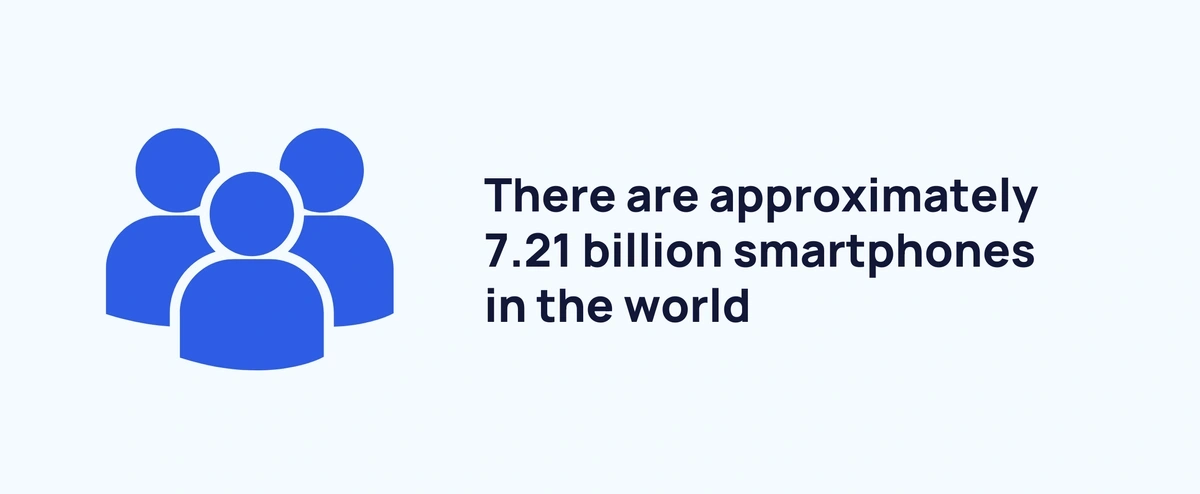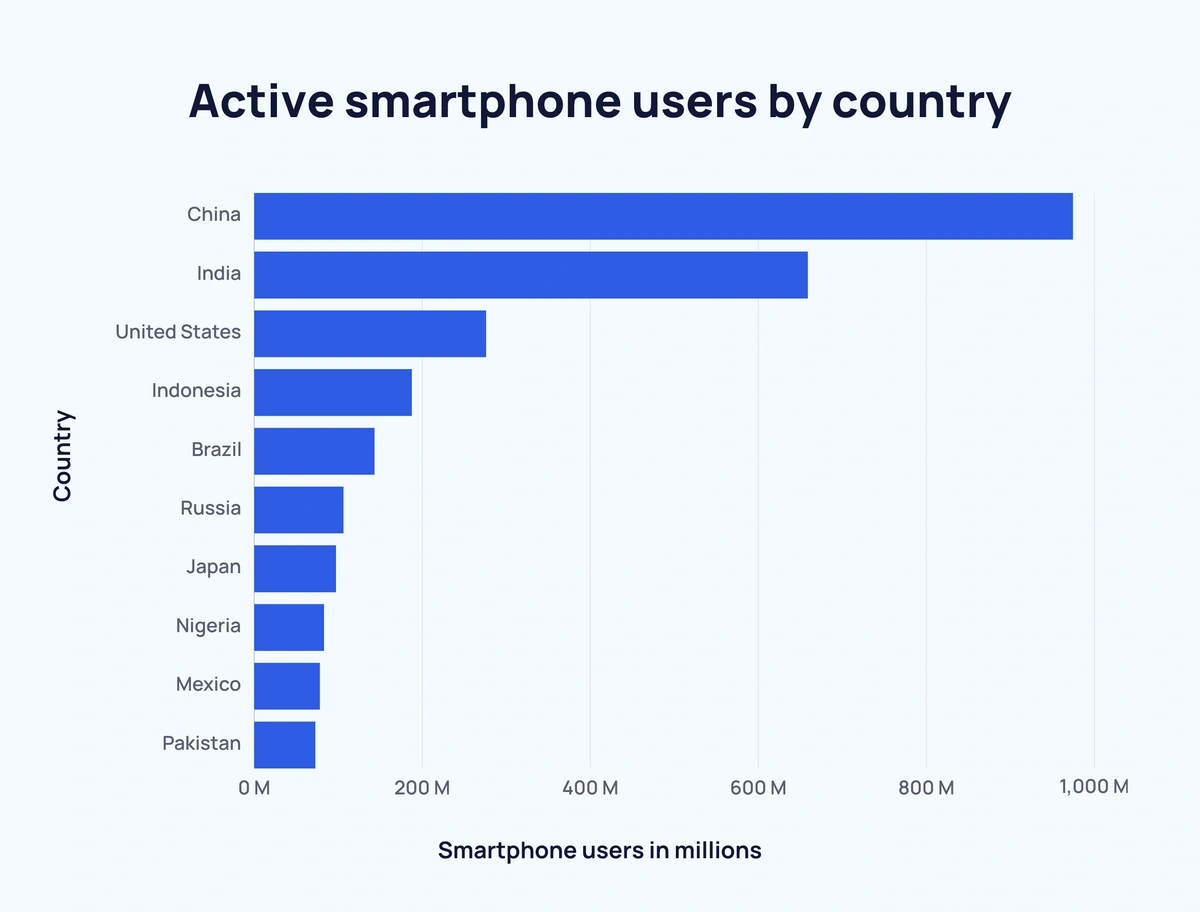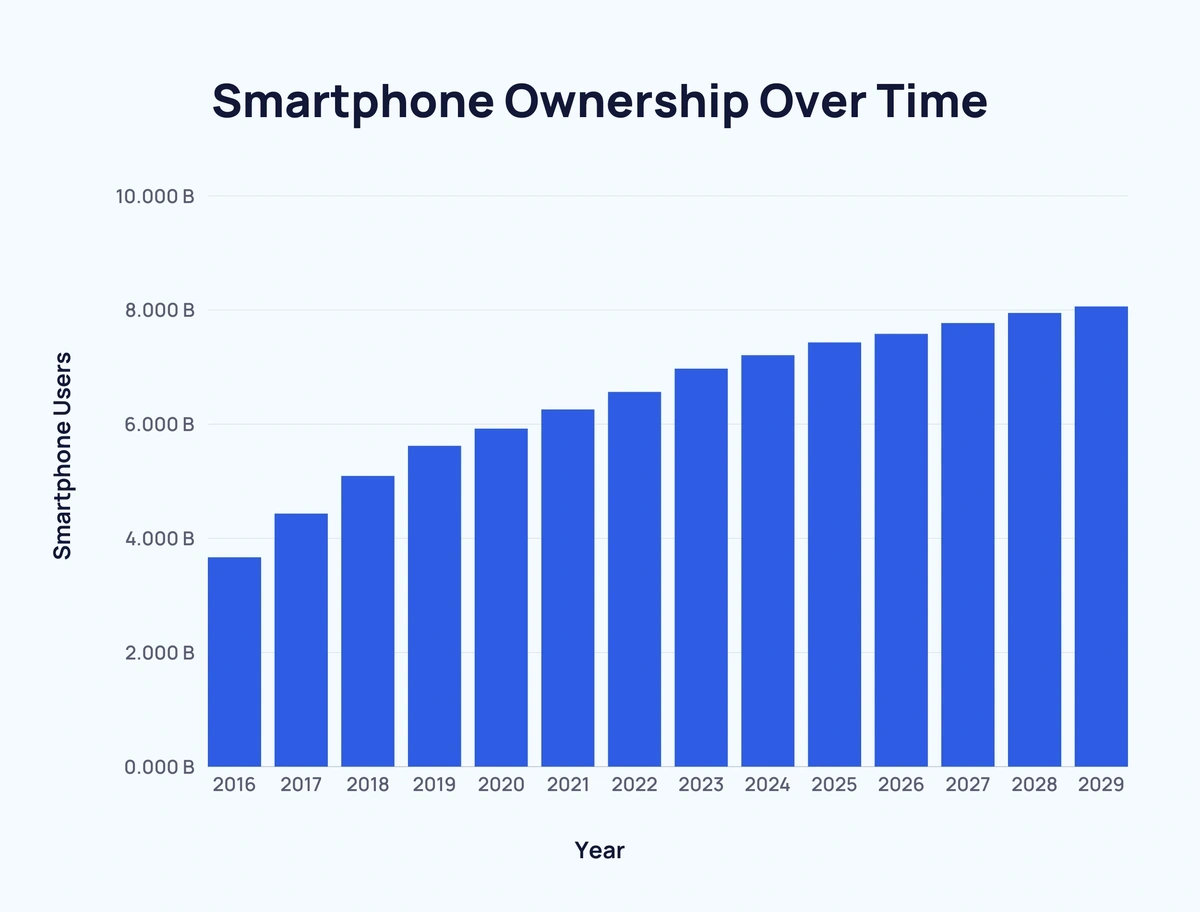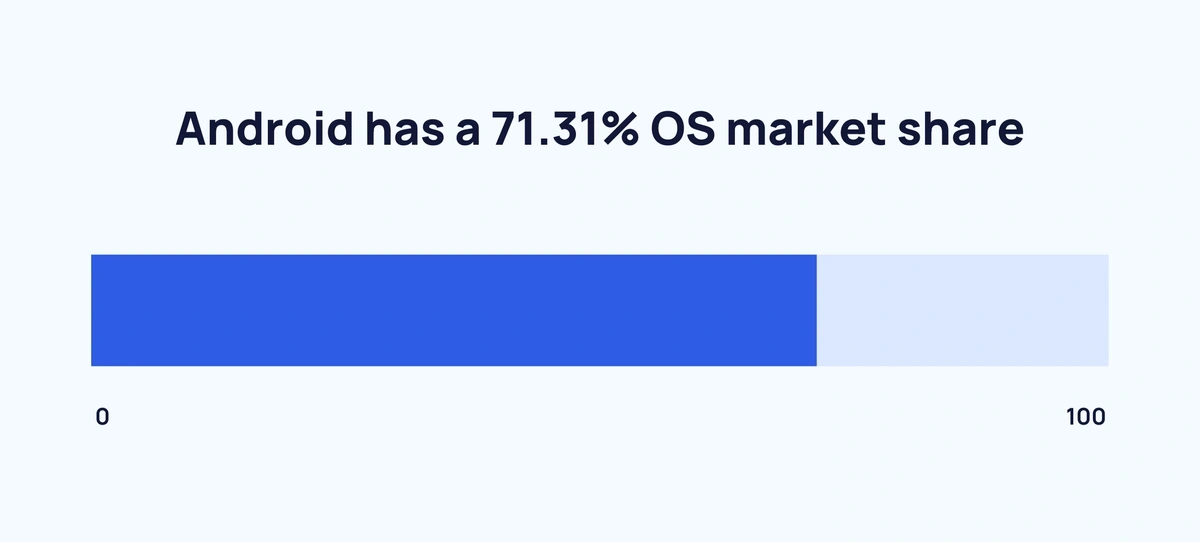
How Many People Own Smartphones? (2025-2029)
Smartphones have become nearly ubiquitous in developed nations across the world. In fact, nearly three-quarters of the top 10 developed countries’ populations own a smartphone.
Globally, almost 90% of cellular phones are smartphones. And the majority of the world’s population currently owns one.
There are currently over 7.2 billion smartphones worldwide — a number that’s projected to increase in the coming years.
In fact, the worldwide smartphone market is expected to expand by 3.09% in 2025 compared to last year.
Smartphone Ownership Statistics (Top Picks)
- There are approximately 7.21 billion smartphones in the world.
- Worldwide smartphone users have increased year-over-year by at least 5% over the last five years.
- There are upwards of 10.47 billion IoT connections worldwide
- Smartphone make up 94.2% of all devices used to access the internet
- China has the most smartphone users in the world
- Germany has the most smartphone usage per capita
- College graduates are most likely to own a smartphone
- Android is the leading mobile operating system worldwide
How Many Smartphones Are There?
Worldwide, there are approximately 7.21 billion smartphones. To put that into perspective, that figure accounts for around 90% of the 8 billion global population.
However, it should be made clear that this does not mean that 90% of people across the globe own a smartphone. In fact, just one country (Germany) has a smartphone penetration rate above 80%.
This is because many people own more than one smartphone. And certain businesses own thousands of phones. To highlight this fact, it is estimated that approximately 10 billion mobile-connected devices are currently in use.
Sources: Statista, Newzoo, OuterBoxDesign
Smartphone Ownership Demographics
The top 10 countries by smartphone users each have upwards of 70 million active smartphone users.
China has the most smartphone users worldwide – almost 1.5x more than any other country.
Of the countries listed, the US has the largest proportion of its population actively using smartphones (81.6%).
Here is a full breakdown of New Zoo’s active smartphone users by country:
| Rank | Country | Smartphone Users | Total Population | Smartphone Penetration |
| 1 | China | 974.69 million | 1.43 billion | 68.4% |
| 2 | India | 659 million | 1.42 billion | 46.5% |
| 3 | United States | 276.14 million | 338.29 million | 81.6% |
| 4 | Indonesia | 187.7 million | 275.5 million | 68.1% |
| 5 | Brazil | 143.43 million | 215.31 million | 66.6% |
| 6 | Russia | 106.44 million | 144.71 million | 73.6% |
| 7 | Japan | 97.44 million | 123.95 million | 78.6% |
| 8 | Nigeria | 83.34 million | 218.54 million | 38.1% |
| 9 | Mexico | 78.37 million | 127.5 million | 61.5% |
| 10 | Pakistan | 72.99 million | 235.82 million | 31% |
Despite these staggering figures, many people do not (and cannot) have access to a smartphone. This is because approximately 1.1 billion people (roughly 1 in 8 people) do not have access to electricity.
Semrush's Traffic Analytics tool allows you to check the demographics of website users. You can create detailed reports that shows users by age group, gender, location, and device.
Want to Spy on Your Competition?
Explore competitors’ website traffic stats, discover growth points, and expand your market share.
US Smartphone User Breakdown
Taking a closer look at US statistics, 19 in 20 people have some form of a cell phone.
According to PewResearch data, the average smartphone user in the US:
Is male
In total, 80% of males own a smartphone compared to 75% of females in the US. There is a 3% difference in favor of females when it comes to owning a non-smartphone cell phone.
Is 18 to 29 years old
Perhaps unsurprisingly, the youngest adult age group features the highest proportion of smartphone users (94%).
The next highest proportion of smartphone users are 30 to 49-year-olds (89%), followed by 50 to 64-year-olds (73%), and rounded off by the 65+ age group (46%).
Lives in an urban area
Again, there’s no surprise in the fact that a larger proportion of US citizens living in urban areas use smartphones (83%) compared to suburban residents (78%) and rural citizens (65%).
Is white/Hispanic
Data shows that ethnicity made very little difference in terms of smartphone users. Around three-quarters of white (77%), Hispanic (77%), and black (75%) populations own a smartphone.
While 98% of black US citizens own some form of cell phone compared to 97% of the Hispanic population and 94% of the white population.
Graduated college
Meanwhile, the level of education showed a positive correlation to smartphone ownership. And a negative correlation to non-smartphone ownership.
Here are the details:
| Education Level | Cell Phone Ownership | Smartphone Only Ownership | Non-Smartphone Only Ownership |
| Less than high-school | 90% | 57% | 33% |
| High-school graduate | 92% | 69% | 24% |
| Some College | 96% | 80% | 16% |
| College graduate | 97% | 91% | 6% |
Earned upwards of $75,000
Lastly, there was also a positive correlation between smartphone ownership and annual salary.
Two-thirds of people earning under $30,000 a year (67%) own a smartphone. There was a small increase between the number of US citizens earning $30,000-$49,999 with a smartphone (82%) and US citizens earning $50,000-$74,999 (83%).
Americans earning over $75,000 a year are most likely to own a smartphone (93%).
Sources: Newzoo, Quartz, PewResearch
Smartphone Ownership Over Time
In the space of half a decade, smartphone users worldwide have increased significantly.
Back in 2016, there were approximately 3.67 billion smartphone users. Since then, this figure has increased year-over-year by at least 300 million.
Between 2016-2021, the number of smartphone owners has increased by 73.88%.
The following table shows smartphone usage growth since 2016:
| Year | Smartphone Users | Growth Over Previous Year | Percentage Growth Over Previous Year |
| 2016 | 3.668 billion | - | - |
| 2017 | 4.435 billion | + 767 million | + 20.91% |
| 2018 | 5.095 billion | + 660 million | + 14.88% |
| 2019 | 5.623 billion | + 528 million | + 10.36% |
| 2020 | 5.924 billion | + 301 million | + 5.35% |
| 2021 | 6.259 billion | + 335 million | + 5.65% |
| 2022 | 6.567 billion | + 308 million | + 4.92% |
| 2023* | 6.974 billion | + 407 million | + 6.2% |
| 2024* | 7.211 billion | + 247 million | + 3.4% |
| 2025* | 7.434 billion | + 223 million | + 3.09% |
| 2026* | 7.584 billion | + 150 million | + 2% |
| 2027* | 7.772 billion | + 188 million | + 2.48% |
| 2028* | 7.949 billion | + 177 million | + 2.28% |
| 2029* | 8.064 billion | + 115 million | + 1.45% |
*estimated
Smartphone ownership is expected to continue to grow over the next 3-4 years.
In 2024, the number of smartphones worldwide exceeded 7 billion. And the proportion of smartphones to cell phones will only become larger.
As of June 2025, smartphones account for 94.2% of all devices used by people aged 16+ to access the internet.
This has only led to an increase in average screen time per day, too. Mobile users spend, on average, 4 hours and 37 minutes on their phones daily.
Here is a look at the forecasted data for smartphones worldwide between 2021 and 2027:
| Year | Number of Smartphones | Number of Mobile Devices | Proportion of Smartphones |
| 2021 | 6.37 billion | 14.91 billion | 42.7% |
| 2022 | 6.57 billion* | 15.96 billion* | 41.17% |
| 2023 | 6.84 billion* | 16.8 billion* | 40.71% |
| 2024 | 7.07 billion* | 17.72 billion* | 39.9% |
| 2025 | 7.30 billion* | 18.22 billion* | 40.07%% |
| 2026 | 7.51 billion* | - | - |
| 2027 | 7.69 billion* | - | - |
*estimated
Source: Ericsson, The Radicati Group
Smartphone Market Share
The smartphone market split has diversified over the last decade.
In 2012, Samsung claimed almost one-third of the smartphone market – the largest single share that year. Besides Apple, (who claimed an 18.7% market share) no other brand claimed more than 4% of the market.
By 2020, five different brands claimed a market share of at least 8%.
Build a winning strategy
Get a complete view of your competitors to anticipate trends and lead your market
Here’s a breakdown of the smartphone market split for select brands since 2012:
| Year | Samsung | Apple | Huawei | Xiaomi | OPPO | vivo | Lenovo |
| 2012 | 30.3% | 18.7% | 4% | - | - | - | 3.3% |
| 2013 | 31.3% | 15.3% | 4.9% | - | - | - | 4.5% |
| 2014 | 24.4% | 14.8% | 5.7% | 4.4% | - | - | 4.6% |
| 2015 | 22.3% | 16.1% | 7.4% | 4.9% | 3% | 2.6% | 5.2% |
| 2016 | 21.1% | 14.6% | 9.5% | 3.6% | 6.8% | 5.3% | - |
| 2017 | 21.7% | 14.7% | 10.5% | 6.3% | 7.6% | - | - |
| 2018 | 20.8% | 14.9% | 14.7% | 8.7% | 8.1% | - | - |
| 2019 | 21.6% | 13.9% | 17.6% | 9.2% | 8.3% | - | - |
| 2020 | 20.6% | 15.9% | 14.6% | 11.4% | - | 8.6% | - |
| Q2 2021 | 18.9% | 14.2% | - | 16.9% | 10.5% | 10.1% | - |
| Q2 2022 | 21.8% | 15.6% | - | 13.8% | 8.6% | 8.7% | - |
The two major mobile operating systems (OS) used in smartphones are Android and iOS.
The mobile OS market share is distributed like this:
- Android has a 71.31% OS market share
- iOS has a 27.73% OS market share
- Samsung has a 0.38% OS market share
- KaiOS has a 0.15% OS market share
- Windows has a 0.02% OS market share
- Nokia Unknown has a 0.01% OS market share
- Linux has a 0.01% OS market share
However, in the US market, iOS leads the way with a 55.48% market share. While Android claims a 44.27% market share.
Sources: IDC, StatCounter
Conclusion
That concludes our roundup of smartphone ownership statistics.
Smartphone adoption continues to grow and is increasingly becoming more widespread across the globe.
There is still some way to go in developing countries, but in the most developed nations, smartphones are becoming near-omnipresent.
If you enjoyed these smartphone statistics, we have pages for in-demand mobile apps and mobile app development trends.
Stop Guessing, Start Growing 🚀
Use real-time topic data to create content that resonates and brings results.
Exploding Topics is owned by Semrush. Our mission is to provide accurate data and expert insights on emerging trends. Unless otherwise noted, this page’s content was written by either an employee or a paid contractor of Semrush Inc.
Share
Newsletter Signup
By clicking “Subscribe” you agree to Semrush Privacy Policy and consent to Semrush using your contact data for newsletter purposes
Written By


Josh is the Co-Founder and CTO of Exploding Topics. Josh has led Exploding Topics product development from the first line of co... Read more






